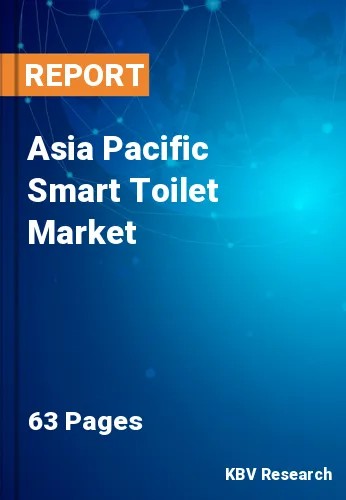The Asia Pacific Smart Toilet Market would witness market growth of 9.9% CAGR during the forecast period (2022-2028).
When someone approaches a smart toilet, the lid will automatically lift as a result of sensors that detect the movement around them. Upon anticipating the arrival, the automatic lids will open, revealing warm seats prepared for the descent. Moreover, once the user leaves, the lids will close on their own. When seated, a pre-mist will moisten the bowl, preventing anything from clinging to it. When the bowl is dry, it keeps debris from clinging and helps maintain the bowl clean so that users have less cleaning to do. Compared to a dry bowl, it is significantly more efficient. It maintains cleanliness without using harmful chemicals.
The majority of manufacturers of smart toilets have taken this into consideration and included automatic preheated seats. This feature prevents the toilet from stinking and offers a pleasant environment to the customer. Additionally, they cooperate with the sensors that catch the movement. The technology would determine the most efficient times to pre-heat the toilet seats after a few months of use. Like a smart TV, the smart toilet would include an energy-saving mode that only activates when it is in use.
Urbanization in India has advanced similarly to urbanization elsewhere in the world as a result of and a byproduct of economic progress. One aspect of the change is the transition of occupations from agricultural to urban-based manufacturing and services. Urbanization has been encouraged concurrently by improved agricultural performance, as seen in some of the country's highest districts for the production of wheat and rice. Only 25 million people, or 10.84% of the population, were living in urban areas in India in 1901. Since then, the number of people living in cities has increased by a factor of 12 and in 2001, accounted for about 285 million people or 28% of the world's population.
The China market dominated the Asia Pacific Smart Toilet Market by Country in 2021, and would continue to be a dominant market till 2028; thereby, achieving a market value of $1,108.4 million by 2028.The Japan market is estimated to grow a CAGR of 9.2% during (2022 - 2028). Additionally, The India market would experience a CAGR of 10.6% during (2022 - 2028).
Based on Application, the market is segmented into Commercial and Residential. Based on Distribution Channel, the market is segmented into Offline and Online. Based on countries, the market is segmented into China, Japan, India, South Korea, Singapore, Malaysia, and Rest of Asia Pacific.
Free Valuable Insights: The Worldwide Smart Toilet Market is Projected to reach USD 13.5 Billion by 2028, at a CAGR of 9.3%
The market research report covers the analysis of key stake holders of the market. Key companies profiled in the report include Xiaomi Corporation, Masco Corporation (Delta Faucet Company), LIXIL Group Corporation (Grohe AG), Roca Sanitario, SA (Roca Corporacion Empresarial, SA), Kohler Co., Toto Ltd., Bradley Corporation, Duravit AG, Wellis Magyarország Zrt., and Fortune Brands Home & Security, Inc.
By Application
By Distribution Channel
By Country
Our team of dedicated experts can provide you with attractive expansion opportunities for your business.

